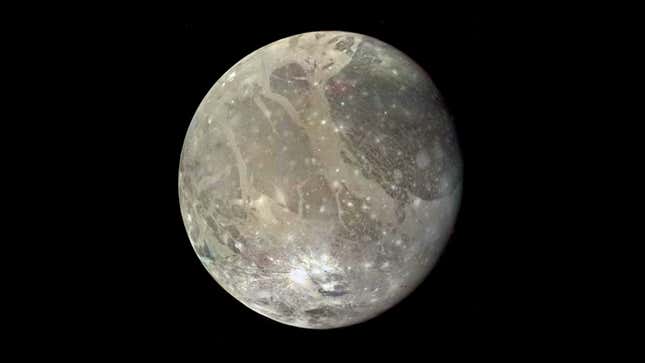
Observations taken 20 years apart by the Hubble Space Telescope suggest that water vapor is present in the atmosphere of Jupiter’s icy moon Ganymede. The findings make the frigid moon an even more intriguing target in the search for extraterrestrial life.
The apparent detection of water vapor came after researchers compared two 1998 observations of Ganymede to another round of observations made in 2018. An analysis determined that sublimated water in the atmosphere would be the most likely culprit for a discrepancy found in the 1998 data. The team who conducted the 2018 observations had their results published in Nature Astronomy today.
In 1998, the Hubble’s Space Telescope Imaging Spectrograph (STIS) instrument took two ultraviolet images of Ganymede, which revealed bands in the moon’s atmosphere similar to Earth’s aurorae, which would mean the moon had a permanent magnetic field. There were slight differences in the ultraviolet observations taken by Hubble at the time, which were ascribed to the presence of atomic oxygen in the atmosphere.

Those observations were followed up in 2018 by ultraviolet observations of Ganymede using Hubble’s Cosmic Origins Spectrograph, which sought to measure the amount of atomic oxygen in the atmosphere and compare that with earlier data, both from 1998 and 2010. But the newer team found barely any atomic oxygen in Ganymede’s atmosphere, indicating the earlier ultraviolet images were showing something else.
The team found the answer in how Ganymede’s aurora was distributed across the two 1998 images. Over the course of a day on Ganymede, its surface temperature rises and falls. When it’s around noon on the moon, the surface could get warm enough to release water molecules.
As Lorenz Roth, the study’s lead author and a planetary astronomer at the KTH Royal Institute of Technology in Sweden, wrote in a recent “Behind the Paper” blog post for Nature, “The difference in the images is exactly there, where water would be expected in the atmosphere. And water vapor has a similar effect as atomic oxygen on the spectral signal...” In other words, what had appeared to be a discrepancy in atomic oxygen could actually be water vapor appearing in one image but not the other, due to the areas of the atmosphere they were targeting.
In a European Space Agency news release, Roth added that the upcoming JUpiter ICy moons Explorer (JUICE) mission could incorporate the recent finding in its investigations of Ganymede and Jupiter’s other icy moons of note, Europa and Callisto. Indeed, Europa is thought to have water plumes that shoot out from a subsurface ocean, and a spacecraft may have flown right through one of these plumes in 1997. Ganymede’s water vapor just makes these worlds all the more intriguing to astrobiologists.